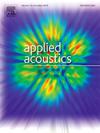改进贝叶斯正则化反问题的振动和声学使用噪声测量
IF 3.4
2区 物理与天体物理
Q1 ACOUSTICS
引用次数: 0
摘要
本文研究了振动和声学问题的吉洪诺夫正则化(脊回归)参数选择。选择方法是基于一种流行的贝叶斯方法,但它纳入了传感器噪声的测量。正则化参数与系统输入能量与噪声能量的比值密切相关,因此噪声测量为推理过程提供信息并改进参数识别。在标准贝叶斯正则化将零作为最优正则化参数的情况下,噪声测量保证了唯一的非零最优。为此制定了充分的理论标准。在声源定位仿真和振动载荷识别实验中,对该方法进行了均匀定态和欠定态的验证。它被证明比现有的经验贝叶斯正则化产生显著的改进。在均匀确定的情况下,改进较大,而在欠确定的情况下,改进较小,其中逆解对正则化参数不太敏感。本文章由计算机程序翻译,如有差异,请以英文原文为准。
Improved Bayesian regularization of inverse problems in vibrations and acoustics using noise-only measurements
This paper studies Tikhonov regularization (ridge regression) parameter selection for problems in vibrations and acoustics. The selection method is based on a popular Bayesian method, but it incorporates measurements of sensor noise. The regularization parameter is closely related to the ratio of system input energy to noise energy, so noise measurements inform the inference procedure and improve parameter identification. In cases where standard Bayesian regularization identifies zero as the optimal regularization parameter, noise measurements guarantee a unique nonzero optimum. Sufficient theoretical criteria are developed for this guarantee. The method is verified in even-determined and under-determined configurations in an acoustic source localization simulation and a vibration load identification experiment. It is shown to yield significant improvements over existing empirical Bayesian regularization. Improvements are larger in the even-determined case and smaller in the under-determined case, wherein the inverse solution is less sensitive to the regularization parameter.
求助全文
通过发布文献求助,成功后即可免费获取论文全文。
去求助
来源期刊

Applied Acoustics
物理-声学
CiteScore
7.40
自引率
11.80%
发文量
618
审稿时长
7.5 months
期刊介绍:
Since its launch in 1968, Applied Acoustics has been publishing high quality research papers providing state-of-the-art coverage of research findings for engineers and scientists involved in applications of acoustics in the widest sense.
Applied Acoustics looks not only at recent developments in the understanding of acoustics but also at ways of exploiting that understanding. The Journal aims to encourage the exchange of practical experience through publication and in so doing creates a fund of technological information that can be used for solving related problems. The presentation of information in graphical or tabular form is especially encouraged. If a report of a mathematical development is a necessary part of a paper it is important to ensure that it is there only as an integral part of a practical solution to a problem and is supported by data. Applied Acoustics encourages the exchange of practical experience in the following ways: • Complete Papers • Short Technical Notes • Review Articles; and thereby provides a wealth of technological information that can be used to solve related problems.
Manuscripts that address all fields of applications of acoustics ranging from medicine and NDT to the environment and buildings are welcome.
 求助内容:
求助内容: 应助结果提醒方式:
应助结果提醒方式:


